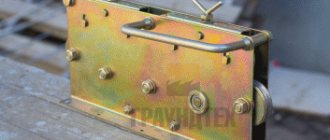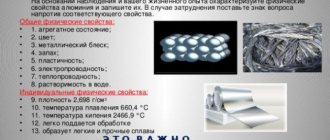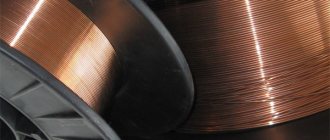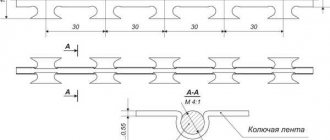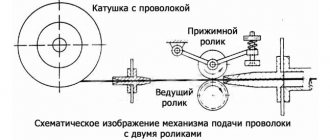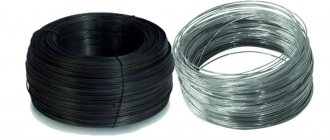Characteristics of the work . Drawing of copper and aluminum wire on drawing mills. Installing the wire on the carousel, threading its ends, pulling it through dies and securing it to the drums. Participation in setting up mills and changing dies. Securing the ends of the wire. Installation of the die mill and threading the ends of the processed wire into the dies. Monitoring the quality of the emulsion. Measuring wire diameter.
Must know: the operating principle of the serviced drawing mills; rules for threading and securing the ends of the wire on the drums; purpose and rules for using the control and measuring instruments and devices used; basic mechanical properties of processed metals; composition of lubricants used when drawing wire from various alloys; basic information about quality and roughness parameters.
§ 6. Wire drawer of the 3rd category in Moscow
Characteristics of the work . Drawing of wire of all profiles with a diameter of up to 1.8 mm of low-carbon steel grades at a drawing speed of up to 300 m/min on single-repeat drawing mills. and from non-ferrous metals. Drawing wire from precious metals and their alloys with a diameter of over 0.09 to 1.0 mm. Welding wire on an electric welding machine. Regulation and maintenance of lubricating and special winding devices, welding machines, removable mechanisms and cooling systems during drawing. Installation and regulation of drawing speed along a given route and drawing mode. Drawing on single and multiple drawing mills of wire with a diameter of over 1.8 mm from low-carbon steel grades at a drawing speed of up to 300 m/min, drawing of wire from non-ferrous metals and alloys with a diameter of over 1.8 to 6 mm under the guidance of a wire drawer of a higher qualification. Removing and tying coils of wire. Preparing skeins and bobbins for drawing. Monitoring the quality of wire winding on the receiving device. Tying of bundles, installation and removal of coils (drums). Pre-adjustment of serviced drawing mills.
Must know: the structure, rules for adjustment of various types of drawing mills and other equipment for drawing; arrangement of the used control and measuring instruments and special devices; procedure for installing and changing dies; basic properties of metals and alloys processed under pressure; wire grades; basic information on qualities and roughness parameters.
Training format for non-ferrous and ferrous metal drawing workers
Our licensed training center in Moscow provides the opportunity to obtain a certificate and certificate of assignment of a profession in the most convenient format. These courses, as well as training for inspectors of scrap and metal waste, are available in the following forms:
- Traditional full-time course based at our educational center, when classes are held in our classrooms according to a pre-approved schedule.
- Distance courses for wire drawing, allowing you to gain the necessary knowledge on the job (electronic classroom, online tests, etc.).
- On-site training at the customer's site.
Course duration is 72 academic hours. To apply for training, use the specified phone number or the online form on the website. After this, we will send you all the necessary data for payment and conclusion of the contract. Access to your personal electronic account will be available immediately after payment.
§ 7. Wire drawer of the 4th category in Moscow
Characteristics of the work . Drawing on single-repeat drawing machines: wires with a diameter of up to 1.8 mm from medium-carbon, high-carbon and alloy steel grades; wire with a diameter of up to 1.8 mm made of low-carbon steel grades with a drawing speed of over 300 m/min; wires with a diameter of over 1.8 mm made of low-carbon marox steel at a drawing speed of up to 300 m/min; wires made of non-ferrous metals with a diameter of over 1.8 to 6.0 mm. Repeated drawing of tungsten, molybdenum and platinum wire, as well as brass, nickel silver and red copper wire for fret plates of all plucked instruments at 7 - 10 grades. Drawing wire from precious metals and their alloys with a diameter of over 0.02 mm. Flattening of wire of various grades on special flattening machines. Under the guidance of a wire drawing operator of a higher qualification, drawing on single and multiple drawing mills: wires with a diameter of over 1.8 mm from low-carbon steel grades at a drawing speed of over 300 m/min; wires with a diameter of over 1.8 mm from medium-carbon, high-carbon and alloy steel grades; wires made of non-ferrous metals with a diameter of over 6.0 mm; bimetallic wire with a diameter of over 2.5 mm; flux-cored wire and wire rod with mechanical descaling. Adjustment of drawing mills. Determination of the quality of metal prepared for drawing after each processing. Calculation of workpiece size. Determination of the required number of broaches, the amount of compression and drawing speed.
Must know: the structure, kinematic diagrams and rules for setting up drawing mills and other equipment for drawing; rules for determining the amount of compression along the passes of drawing mills and drawing speed; technical specifications for the raw materials used and manufactured products; methods of influence of etching and annealing on the quality of drawn metal; rules defining the sequence of wire drawing and the number of broaches for certain metals; design of special devices; basic information about quality and roughness parameters.
Wire drawer Manufacture of machinery and equipment Profession of workers
Tariff and qualification characteristics of the profession “Wire Drawer” are required to determine the types of work, tariff rates and assignment of ranks in accordance with Article 143 of the Labor Code of the Russian Federation.
Based on the specified characteristics of the work performed and the requirements for professional knowledge and skills, a job description for a wire drawer is drawn up, as well as personnel documents, including for interviews and testing when hiring.
When drawing up work (job) instructions, it is necessary to take into account the general provisions and recommendations for the release of ETKS 15; if there is not enough information, please search for a profession through the catalog of professions and specialties in alphabetical order.
Wire drawer 2nd category
Characteristics of the work. Drawing of copper and aluminum wire on drawing mills. Installing the wire on the carousel, threading its ends, pulling it through dies and securing it to the drums. Participation in setting up mills and changing dies. Securing the ends of the wire. Installing dies on the mills and threading the ends of the processed wire into the dies. Monitoring the quality of the emulsion. Measuring wire diameter.
Must know: the operating principle of serviced drawing mills; rules for threading and securing the ends of the wire on the drums; purpose and rules of use of the used control and measuring instruments and devices; basic mechanical properties of processed metals; composition of lubricants used when drawing wire from various alloys; basic information about quality and roughness parameters.
Wire drawer 3rd category
Characteristics of the work. Drawing on single and multiple drawing mills of wire of all profiles with a diameter of up to 1.8 mm from low-carbon steel grades at drawing speeds of up to 300 m/min and from non-ferrous metals. Drawing wire from precious metals and their alloys with a diameter of over 0.09 to 1.0 mm. Welding wire on an electric welding machine. Adjustment and maintenance of lubricating and special winding devices, welding machines, removable mechanisms and drawing cooling systems. Setting and regulation of drawing speed along a given route and drawing mode. Drawing on single and multiple drawing mills of wire with a diameter of over 1.8 mm from low-carbon steel grades at a drawing speed of up to 300 m/min, drawing of wire from non-ferrous metals and alloys with a diameter of over 1.8 to 6 mm under the guidance of a wire drawer of a higher qualification. Removing and tying coils of wire. Preparing skeins and bobbins for drawing. Monitoring the quality of wire winding on the receiving device. Tying of bundles, installation and removal of coils (drums). Adjustment of serviced drawing mills.
Must know: the structure, rules for adjustment of various types of drawing mills and other equipment for drawing; arrangement of the used control and measuring instruments and special devices; procedure for installing and changing dies; basic properties of metals and alloys processed under pressure; wire grades; basic information about quality and roughness parameters.
Wire drawer 4th category
Characteristics of the work. Drawing on single and multiple drawing machines: wires with a diameter of up to 1.8 mm from medium-carbon, high-carbon and alloy steel grades; wires with a diameter of up to 1.8 mm from low-carbon steel grades at a drawing speed of over 300 m/min; wires with a diameter of over 1.8 mm made of low-carbon steel grades at drawing speeds of up to 300 m/min; wires made of non-ferrous metals with a diameter of over 1.8 to 6.0 mm. Repeated drawing of tungsten, molybdenum and platinite wire, as well as brass, nickel silver and red copper wire for fret plates of all plucked instruments at 7-10 grades. Drawing wire from precious metals and their alloys with a diameter of over 0.02 mm. Flattening of wire of various grades on special flattening mills. Under the guidance of a wire drawing operator of higher qualifications, drawing on single and multiple drawing mills: wires with a diameter of over 1.8 mm from low-carbon steel grades at a drawing speed of over 300 m/min; wires with a diameter of over 1.8 mm from medium-carbon, high-carbon and alloy steel grades; wires made of non-ferrous metals with a diameter of over 6.0 mm; bimetallic wire with a diameter of over 2.5 mm; flux-cored wire and wire rod with mechanical descaling. Setting up drawing mills. Determination of the quality of metal prepared for drawing after each processing. Calculation of workpiece size. Determination of the required number of broaches, the amount of compression and drawing speed.
Must know: the structure, kinematic diagrams and rules for setting up drawing mills and other equipment for drawing; rules for determining the amount of reduction along the passes of drawing mills and drawing speed; technical specifications for the raw materials used and manufactured products; methods of influence of etching and annealing on the quality of metal during drawing; rules defining the sequence of wire drawing and the number of broaches for certain metals; design of special devices; basic information about quality and roughness parameters.
Wire drawer 5th category
Characteristics of the work. Drawing on single and multiple drawing machines: wires with a diameter of over 1.8 mm from low-carbon steel grades at a drawing speed of over 300 m/min; wires with a diameter of over 1.8 mm from medium-carbon, high-carbon and alloy steel grades, wires from non-ferrous metals with a diameter of over 6.0 mm; wires made of resistance alloys and stainless steel grades; flux-cored wire and wire rod with mechanical descaling. Repeated drawing of tungsten, molybdenum and tantalum wire at grade 6. Drawing wire from precious metals and their alloys with a diameter of up to 0.02 mm. Wire drawing on high-speed mills with individual DC drives.
Must know: the design of drawing mills of various types; types of wire drawing and number of broaches for various metals; wire drawing technology; composition of the emulsion supplied to the drawing mills.
§ 8. Wire drawer of the 5th category in Moscow
Characteristics of the work . Drawing on single-repeat drawing machines: wires with a diameter of over 1.8 mm of low-carbon steel grades at a drawing speed of over 300 m/min; wires with a diameter of over 1.8 mm of medium-carbon, high-carbon and alloyed steel grades; wires made of non-ferrous metals with a diameter of over 6.0 mm; wires made of resistance alloys and stainless steel grades; flux-cored wire and wire rod with mechanical descaling. Repeated drawing of tungsten, molybdenum and tantalum wire of grade 6. Drawing of wire from precious metals and their alloys with a diameter of up to 0.02 mm. Wire drawing on high-speed mills with individual direct current drives.
Must know: the design of drawing mills of various types; types of wire drawing and number of broaches for various metals; wire drawing technology; composition of the emulsion supplied to the drawing mills.
